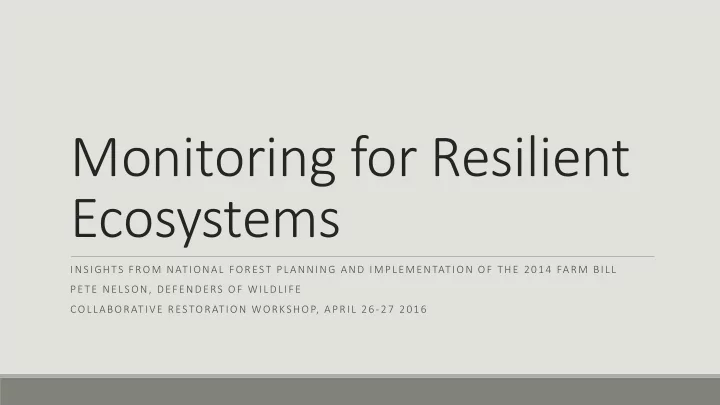

Monitoring for Resilient Ecosystems INSIGHTS FROM NATIONAL FOREST PLANNING AND IMPLEMENTATION OF THE 2014 FARM BILL PETE NELSON, DEFENDERS OF WILDLIFE COLLABORATIVE RESTORATION WORKSHOP, APRIL 26-27 2016
Outline Ecological resiliency – A unifying policy objective ◦ But how to define and measure? Ecological Integrity: A framework to assess, plan, manage and monitor for ecosystem persistence Implementation Case Study: 2014 Farm Bill ◦ Assessing and prioritizing for resiliency ◦ Collaborative, active adaptive management
Resiliency: A unifying policy objective The restoration and enhancement of ecosystem resilience is a management priority on U.S. public lands. THE desired ecosystem condition 2012 Planning Rule 2014 Farm Bill Forestry provisions Imagine if everyone asked: Is our program/project enhancing ecosystem resiliency? How to evaluate success?
Resiliency: Concept “The capacity to reorganize while Ecosystem processes or services undergoing change so as to still retain the essentially same function, structure, identity and feedbacks” (Walker et al 2004) Climate change, departed (unsustainable) conditions, uncharacteristic wildfire, insect & disease, drought… Loss of ecosystems (and ecosystem services) How to measure? What parts and processes are crucial to allow for persistence? Ecosystem state
Ecological integrity : A framework for measuring ecosystem condition The primary conservation framework of the 2012 Planning Rule Multijurisdictional/all lands (ecosystem is the unit of analysis) Replicable across space and time (powerful) 1. Describe ecosystems based on parts (composition), arrangement (structure), and process 2. Use reference conditions to estimate current ecosystem departure to prioritize actions and establish desired conditions
Portraying an ecosystem Development of multiple metrics to describe an ecosystem (and multiple hypotheses about Ecological Integrity what is most important) Consistent (replicable) method for portraying and measuring complex ecosystems, Structure Function Composition documenting assumptions, uncertainty and collecting ecological information Arrangement of Type, frequency, Presence and Opportunity for stakeholders to see their successional patches severity of abundance of at-risk on the landscape disturbances species values “represented” in an ecosystem (good in collaborative settings) Ability of species to Distribution and extent Snag density, size and Evaluation of long-term effectiveness and move within and of major vegetation distribution throughout plan areas types short-term impacts
Manage for multiple characteristics, with ranges of desired conditions Define the ecosystem of interest Select multiple key characteristics of integrity thought to be most essential (based on relevant science) Estimate a reference condition (using historical information and projecting future scenarios) Hypothesis: Characteristics departed from reference conditions are of resilience concern (at risk or vulnerable) Establish a range of desired conditions for each key characteristic of integrity (no single DC) Manage the ecosystem for those conditions and monitor
Implementing the 2014 Farm Bill 2014 Farm Bill Forestry provisions designated 44+ million National Forest Risks to resiliency due to insect & disease Collaboration, categorical exclusions Best available science to maintain or restore ecological integrity (structure, function, composition) An opportunity to evaluate the effectiveness of a national program to enhance ecosystem resiliency
Using ecological information to prioritize landscapes for resiliency 1M acres impacted by MBP, enhanced fire risk, loss of ecosystem services Recommended 7 landscapes for designation using multiple metrics ◦ Insect & disease risk ◦ Fire regime condition class/uncharacteristic wildfire risk ◦ Watershed condition class ◦ WUI Collaboratively develop and monitor resiliency projects within priority landscapes
Active Adaptive Management Useful when cases of high uncertainty/low consensus on resiliency actions (e.g. mixed severity/stand replacing fire regimes) Compare multiple alternative resiliency treatments using principles of experimental design (not research) Untreated controls (no action/trust building for skeptics) Hedging: Multiple treatments for resiliency (heterogeneity/range of resilient conditions)
Recommend
More recommend